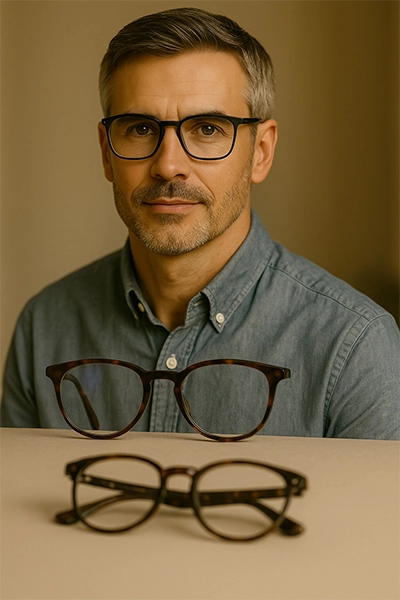
What to Know About Progressive and Multifocal Lenses
After the age of 40, presbyopia makes it difficult to focus on close objects. Progressive lenses, also known as multifocal lenses, provide a smooth transition from distance to near vision without changing glasses. However, not all lenses are the same. In this guide, we will explore what you need to know before choosing them: advantages, limitations, adaptation, and differences between types of lenses.
What are Progressive Lenses (or Multifocal Lenses)
Progressive lenses have multiple diopter powers in a single optical surface, allowing vision at all distances. They do not have visible lines like bifocals, offering a more modern aesthetic and a more natural visual experience.
Who They Are Recommended For
- People with presbyopia who want a single pair of glasses
- Those who frequently use computers, smartphones, and read up close
- Those tired of switching between two different pairs of glasses
- Active individuals who move between different environments throughout the day
Advantages of Progressive Lenses
- A single lens for all distances
- Gradual transition between visual fields
- Aesthetic look without visible interruptions
- Daily comfort for those who work, drive, read, and move frequently
Limitations and Adaptation Period
- Subjective adaptation: can take from a few days to 2-3 weeks
- Peripheral distortion in the lateral areas of the lenses (depends on quality)
- Require optimal centering and precise measurements (interpupillary distance, mounting height)
Difference Between Standard and Customized Progressive Lenses
| Type of Lens | Main Characteristics |
|---|---|
| Standard | Fixed visual scheme, more affordable |
| Customized | Optimized for posture, usage, and selected frame |
| Occupational | For specific use (e.g., computer, office, laboratory) |
How Much They Cost and What Affects the Price
- Type of lens (standard vs customized)
- Included treatments (anti-reflective, scratch-resistant, blue light filter)
- Material of the lens (CR39, polycarbonate, high-index organic)
- Brand and precision of optical processing
- Included after-sales services (adjustments, fittings, warranty)
Errors to Avoid When Buying Progressive Lenses
- Using a frame that is too small
- Ordering online without precise measurements
- Ignoring the optician's advice for the adaptation phase
- Expecting immediate comfort with cheap lenses
- Frequently changing posture instead of using the gaze correctly
Recommended Brands and Labs
- Essilor (Varilux): pioneers in customized progressive lenses
- Hoya: excellent clarity and precision, even for complex frames
- Zeiss: high performance, even for sensitive eyes
FAQ – Frequently Asked Questions
❓ Is it normal to feel discomfort in the first few days?
Yes. It takes time to get used to the different visual fields. On average, it takes about 7-10 days.
❓ Are progressive lenses also good for the computer?
Yes, but if you work many hours in front of the screen, it's better to opt for specific occupational lenses.
❓ Are there progressive lenses for sunglasses?
Yes. There are progressive lenses with photochromic lenses (that darken in the sun) or polarized.
❓ Is it better to have standard or customized progressive lenses?
If you use them every day, customized lenses offer significantly superior comfort.